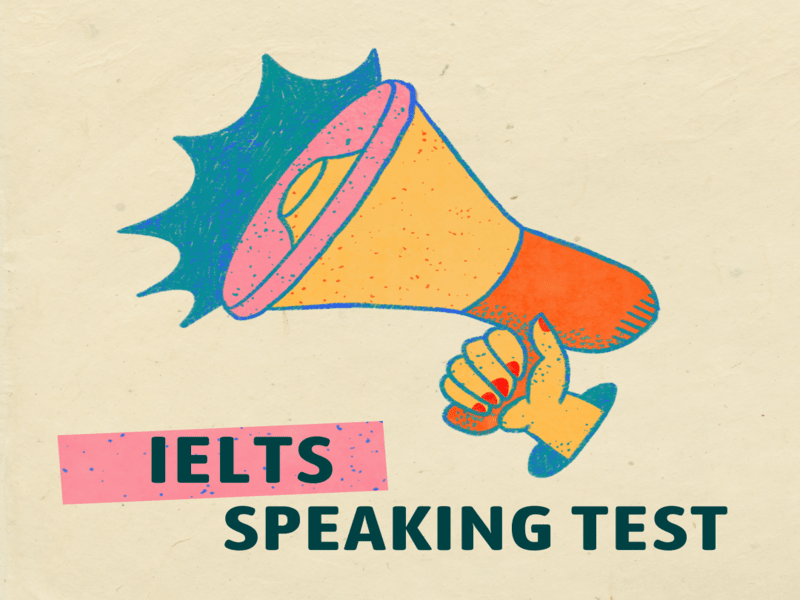Attempting the IELTS Speaking test can be unnerving. The thought of giving a recorded interview to a total stranger can unsettle even a native English speaker. So you must prepare and practice for the test, however, Before you start practising it is also important to understand what to expect in the test.
The IELTS Speaking test is identical for both IELTS Academic and IELTS General Training. The test lasts 11 to 14 minutes. It is a recorded face-to-face interview between the examiner and the test taker.

Skills tested
IELTS Speaking tests the following skills
- Fluency
- Vocabulary
- Grammar
- Pronunciation
The test has three parts
Part 1
In part 1, the examiner will ask questions about yourself, your family, interests, hobbies, etc. It lasts for about 4-5 minutes.
The interaction in part is a way to start the conversation by starting with fundamental topics and questions.
Example of the communication in Part 1
After you walk into the interview room the examiner will introduce themselves
Examiner: “Hi My name is Karen and I will be interviewing you today”
Test taker: “Hi My name is Suresh. Nice to meet you.”
Examiner: “Where are you from?”
Test taker: “I am from (Mention where you are from).”
Examiner: “Please share your identification(passport).”
Show your identification (Passport) to the examiner. Your test will begin after this.
The examiner will ask you questions from 2-3 familiar topics like your job, studies, hometown, family, country, etc.
An example of one such conversation
Examiner: “Let’s talk about your job.”
Test taker: “Okay”
Examiner: “What field is your job in?”
Test taker: “I work in the IT field.”
Examiner: “What is your job role?”
Test taker: “I work as a software developer.”
Examiner: “What do you like about your job?”
Test taker: “I have always been passionate about technology, especially Information Technology. I Love to create applications and my job allows me to follow my passion.”
Examiner: “Anything that you don’t like about your job?”
Test taker: “The timelines for the delivering work can be very strict and very stressful.”
Part 2
In part 2 the examiner will show you a card. This card will have a topic. You will get a minute to prepare and then speak for about two minutes on it. The examiner will then ask you some general questions about the same topic.
Example of the communication in Part 2
Topic: Describe something you own which is very important to you
Test taker: “I own a motorcycle and it is very important to me because It is the first vehicle I purchased with my earnings. I saved a part of my salary for nearly six months before I could purchase it. in those six months, I planned what brand, model, and colour I would buy. I have had this motorcycle for more than 20 years now and I have always maintained it well. The motorcycle’s registration has expired but I have kept it because I feel emotionally attached to it.”
Examiner: Would you sell it if you bought a new motorcycle?
Test taker: If I buy a new motorcycle I might end up selling it due to space constraints and the cost and time involved in maintaining 2 motorcycles.
Part 3
In part 3 the examiner asks detailed questions about the same topic and this part has a longer duration.
Example of the communication in Part 3
Examiner: “We have discussed your motorcycle, now I will ask you a few general questions about the topic. What is the most popular motorcycle brand in your country? “
Test taker: “Royal Enfield is the most popular brand of motorcycles in my country.”
Examiner: “Do people prefer motorcycles over cars?”
Test taker: “No, both are equally popular normally youngsters buy motorcycles and middle-aged people prefer to buy a car.”
Examiner: “Is it safe to drive motorcycles in your city?”
Test taker: “No, it’s not safe to drive two-wheelers in the city.”
Examiner: “Then why do you think they are so popular? “
Test taker: “Motorcycles are easier to drive in traffic, finding parking for them is also easy and cheap. They are also economical when it comes to maintenance and fuel costs.”
IELTS Speaking assessment criteria
There are four assessment criteria for the IELTS Speaking test.
Fluency and Coherence
Fluency refers to the ability to speak at a continuous rate of speech. This criterion checks whether a test taker speaks comfortably at a continuous rate of speech without any hesitations or fillers and that speech is easily understandable. Coherence refers to the quality of speech that makes it understandable to the listener.
Fluency parameters
Speech rate – The rate of speech should neither be fast nor slow. It should be moderate. take time to speak each word.
Speech continuity – The flow of speech should be continuous, devoid of any false starts, self-corrections, fillers like um, uh, etc. pauses in speech caused due to limited vocabulary and repetition of words and sentences.
Coherence parameters
Logical sequencing – The spoken sentences should be in a logical sequence. In other words, if you use the correct words to convey the meaning but their sequence in the sentence is not correct you will lose marks for coherence.
Discourse markers – Discourse markers are words like because, well, however, etc. that are used to organize and structure a discourse.
Cohesive devices – Cohesive devices are also known as linking words or connectors, they also act as signposts as they tell the listener what to expect next, for example, the use of and in a sentence tells the listener that another point in addition to the previous points is coming. The use of because tells them to expect the cause of what was spoken earlier. this also helps to link the ideas within a sentence. To link ideas between sentences you can use words like in addition or conclusion.
Lexical resource
The lexical resource refers to the range of vocabulary a test taker has at their disposal to explain their thoughts and ideas effectively.
Lexical resource parameters
A variety of words used – The variety of words a test taker uses in the speaking test displays their vast vocabulary. Having a good vocabulary positively impacts the fluency of a test taker too. It’s like a vast pool of words to choose from.
Adequate and appropriate vocabulary – Having an adequate and appropriate vocabulary is important so that the words chosen convey the correct meaning, style(formal/informal) and the correct attitude.
Ability to paraphrase – Having a good vocabulary at one’s disposal helps in paraphrasing. Paraphrasing is the ability to convey something in your words by using simple words making it easier to understand.
Grammatical range and accuracy
This refers to having good control over grammar and using the correct grammatical syntax in spoken language.
Grammatical range parameters
Sentence length
Appropriate use of subordinate clauses – A subordinate clause is part of a sentence that doesn’t make sense alone. It needs a main clause to complete the sentence e.g. “I need to get back home before dark”
The main clause – I need to get back home.
Subordinate clause – Before dark
Complexity of verb phrase – A verb phrase consists of a main verb + ing + auxiliary verb e.g. “People were talking.“
Where the main verb is talk + ing, and the auxiliary verb is were.
Complexity of other phrases
Use of sentence structures – Can use different types of sentence structures.
Grammatical accuracy parameters
Error density – Refers to the number of errors in speech during the test.
Communicative effect of error – The effect of grammatical error in spoken communication.
Pronunciation
This refers to the ability to pronounce words like a native English speaker. This doesn’t refer to copying the accent but using the correct intonation, stress, and rhythm to convey the correct meaning.
Pronunciation parameters
Meaningful division of speech – The test taker should be able to divide the sentence into meaningful parts.
Rhythm – The speech should have a rhythm, and use of Elision (Omission of sounds or syllables e.g. could’ve, let’s, etc.)
Intonation – the ability to speak at varying levels of pitch by stressing certain words to convey the correct meaning.
Use of Accent – the use of accent to a level that doesn’t negatively impact the speech’s understanding.
